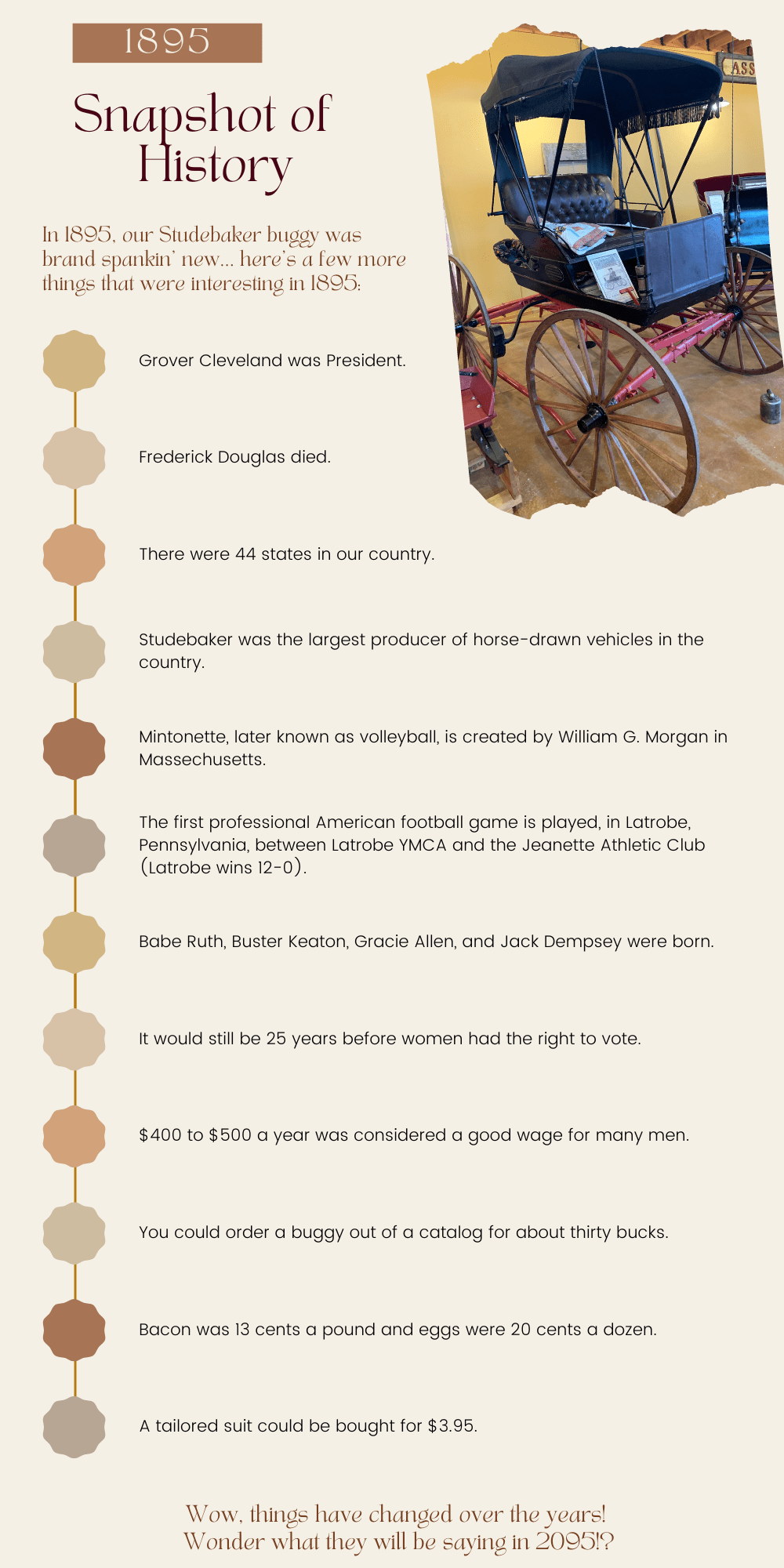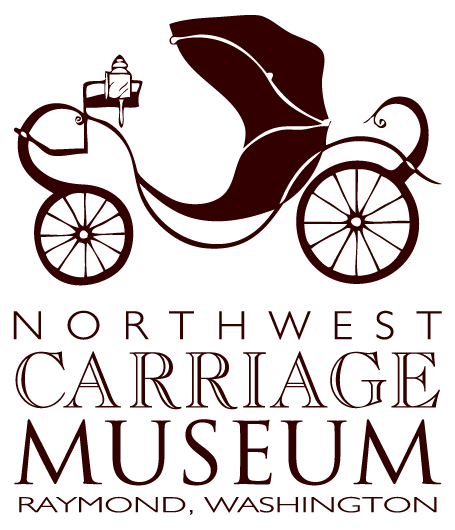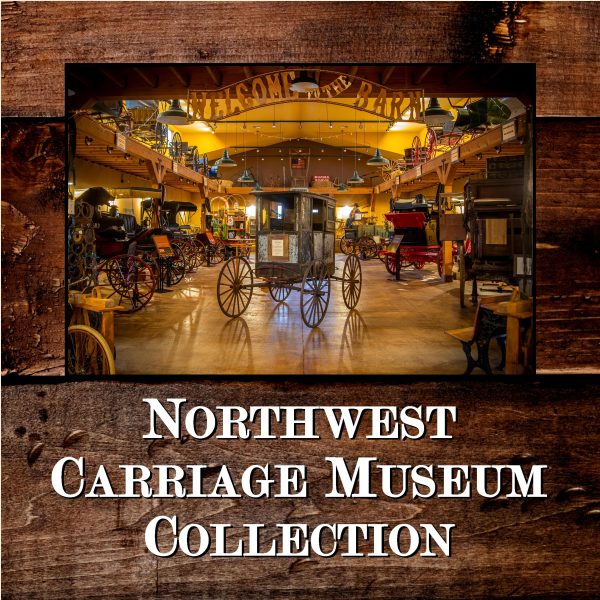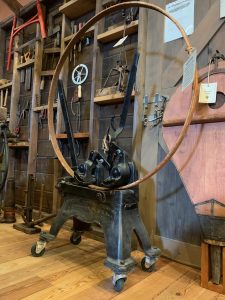 A tire shrinker (originally spelled “tyre”) was an important tool in the blacksmith/wheelwright shop back in the day of horse drawn transportation. Also known as an “upsetter,” the tire shrinker was used to resize the metal band that went around the wooden spoked wheels of buggies, wagons and carriages. When the hub and/or spokes dried out due to age or weather, the metal band, called a tire or tyre, became loose. The tire would be removed from the wheel, heated, and put into this machine. It would then be “upset” or squeezed leaving a small bulge which would be hammered flat and trimmed on the edges. This process created a tire which was slightly smaller in circumference. At this point, the tire would be reinstalled on the wheel. Our tire shrinker was once part of a blacksmith shop in Oklahoma and is a remarkable piece of American history.
A tire shrinker (originally spelled “tyre”) was an important tool in the blacksmith/wheelwright shop back in the day of horse drawn transportation. Also known as an “upsetter,” the tire shrinker was used to resize the metal band that went around the wooden spoked wheels of buggies, wagons and carriages. When the hub and/or spokes dried out due to age or weather, the metal band, called a tire or tyre, became loose. The tire would be removed from the wheel, heated, and put into this machine. It would then be “upset” or squeezed leaving a small bulge which would be hammered flat and trimmed on the edges. This process created a tire which was slightly smaller in circumference. At this point, the tire would be reinstalled on the wheel. Our tire shrinker was once part of a blacksmith shop in Oklahoma and is a remarkable piece of American history.
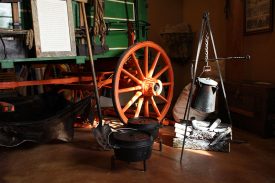
Chuckwagon Coffee Tipper over the campfire
When I look at a chuckwagon, I see much more than a range kitchen. Sure the kitchen was there for all the meals, coffee and biscuits for breakfast, beans, biscuits, meat, cobbler and coffee for supper; when the chuckwagon was set up there was always a pot of strong coffee brewing. But the chuckwagon was so much more to the cowhands far from home. While the cowhands were responsible for moving the herd, “Cookie” and his chuckwagon were responsible for moving the cowhands. The trail boss was officially in charge but it was “Cookie” who was always respected, never talked back to and issued most of the orders. After all, he not only fed you but also mended your clothes, had the medical supplies, moved your bedroll and belongings to the next camp, provided the entertainment, provided a place to wash up and shave and, most importantly, always had that pot of coffee going to rinse the trail dust from your throat. On a special occasion, “Cookie” might even break out a jug for a little nip of whiskey. Yea, you never wanted to be on the wrong side of Ol’ Cookie!
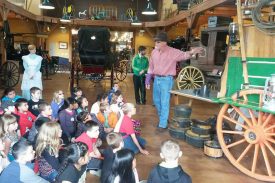
A field trip lesson about life on the range
The chuckwagon history is interesting. At the end of the civil war, lots of people were moving West and the market for beef expanded greatly. Cattleman, recognizing the need to move large herds without the help of railroads, developed the “trail drive” concept. Moving 1200 to 2000 head of cattle with 10 to 12 cowhands was not easy. Out on the trails for months at a time, these young men endured many hardships but it was “Cookie” and the chuckwagon at the end of the day who supplied the needed comfort. The chuckwagon was the gathering place, and sitting around the campfire, eating a meal, sipping some coffee, the cowhand was home.
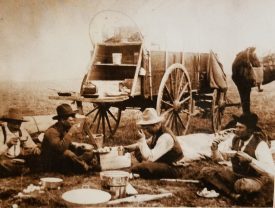 Credit for the chuckwagon goes to Charles Goodnight, a Texas rancher also known as the “father of the panhandle,” who invented it in 1866. Chuckwagons were built on numerous wagon running gears: ours is an 1890s chuckwagon built on a Spingfield Wagon Company gear. Springfield Wagons were known for their quality and durability, were marketed as “The Old Reliable” wagon, and were built from 1873 to 1951. This chuckwagon was used by its previous owners at chuckwagon food competitions throughout the Southwest and has won awards for its authenticity.
Credit for the chuckwagon goes to Charles Goodnight, a Texas rancher also known as the “father of the panhandle,” who invented it in 1866. Chuckwagons were built on numerous wagon running gears: ours is an 1890s chuckwagon built on a Spingfield Wagon Company gear. Springfield Wagons were known for their quality and durability, were marketed as “The Old Reliable” wagon, and were built from 1873 to 1951. This chuckwagon was used by its previous owners at chuckwagon food competitions throughout the Southwest and has won awards for its authenticity.
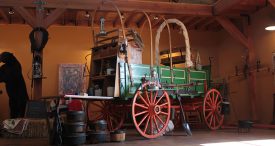 If you haven’t seen her, come on in for a visit… our chuckwagon is a real beauty!
If you haven’t seen her, come on in for a visit… our chuckwagon is a real beauty!
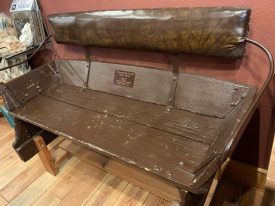 Our old wooden wagon seat is an incredible piece of Washington State history.
Our old wooden wagon seat is an incredible piece of Washington State history.
The Longacres Racetrack in Renton was founded in 1933 by Seattle Real Estate magnates Joseph Gottstein (1891-1971) and William Edris and designed by B. Marcus Priteca. The track’s storied history is amazing. State legislation allowing pari-mutuel betting was passed in early 1933 and signed into law by Gov. Clearance Martin on March 13, 1933.
The track closed to live racing on September 21, 1992. The Seattle Post-Intelligencer reported, “Before the last race, announcer Gary Henson told the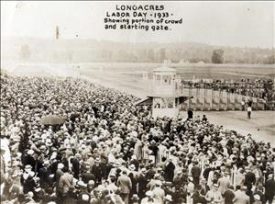 crowd, ‘These horses belong to you. Listen to their final thunder.'” Then, for probably the first time in track history, the race was run in silence, without Henson’s customary calls (September 22, 1992). More than 23,000 fans crowded the stands to see Native Rustler, ridden by Gary Stevens, win the final race.
crowd, ‘These horses belong to you. Listen to their final thunder.'” Then, for probably the first time in track history, the race was run in silence, without Henson’s customary calls (September 22, 1992). More than 23,000 fans crowded the stands to see Native Rustler, ridden by Gary Stevens, win the final race.
For many years, our wagon seat was part of the decor in the jockey’s locker room. Over the years, hundreds of jockey’s used the seat for “booting up” before a race. The seat was removed during demolition of the track and was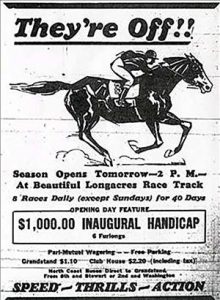 in a private collection until gifted to our museum several years ago. Oh… if that seat could talk!
in a private collection until gifted to our museum several years ago. Oh… if that seat could talk!
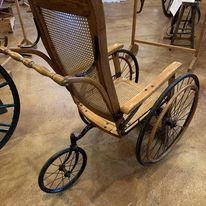
A new addition to our collection of period artifacts: an 1880s wooden wheelchair with original cane seat and back.
It is believed one of the first wheelchairs was invented for King Phillip of Spain in 1595. The King suffered from severe gout which made walking difficult. The first self propelled wheelchair was invented by a paraplegic German clock maker in 1655. In 1783, the “bath chair” was invented in Bath, England for sick and injured people visiting the famous Bath mineral springs. Throughout the 19th century, wheelchair design improvements were made including wooden framed chairs with backs and seats made of cane. After the Civil War, additional improvements were made such as wire spoked wheels and rubber tires. This wheelchair, which we were lucky enough to recently add to our collection, is estimated to be from the early 1880s. Wheelchair design improvements continued into the 20th century, with the folding tubular wheelchair being invented in 1932. Modern day wheelchairs are much lighter weight, more easily transported, and motorized in some cases.
 A tire shrinker (originally spelled “tyre”) was an important tool in the blacksmith/wheelwright shop back in the day of horse drawn transportation. Also known as an “upsetter,” the tire shrinker was used to resize the metal band that went around the wooden spoked wheels of buggies, wagons and carriages. When the hub and/or spokes dried out due to age or weather, the metal band, called a tire or tyre, became loose. The tire would be removed from the wheel, heated, and put into this machine. It would then be “upset” or squeezed leaving a small bulge which would be hammered flat and trimmed on the edges. This process created a tire which was slightly smaller in circumference. At this point, the tire would be reinstalled on the wheel. Our tire shrinker was once part of a blacksmith shop in Oklahoma and is a remarkable piece of American history.
A tire shrinker (originally spelled “tyre”) was an important tool in the blacksmith/wheelwright shop back in the day of horse drawn transportation. Also known as an “upsetter,” the tire shrinker was used to resize the metal band that went around the wooden spoked wheels of buggies, wagons and carriages. When the hub and/or spokes dried out due to age or weather, the metal band, called a tire or tyre, became loose. The tire would be removed from the wheel, heated, and put into this machine. It would then be “upset” or squeezed leaving a small bulge which would be hammered flat and trimmed on the edges. This process created a tire which was slightly smaller in circumference. At this point, the tire would be reinstalled on the wheel. Our tire shrinker was once part of a blacksmith shop in Oklahoma and is a remarkable piece of American history.







